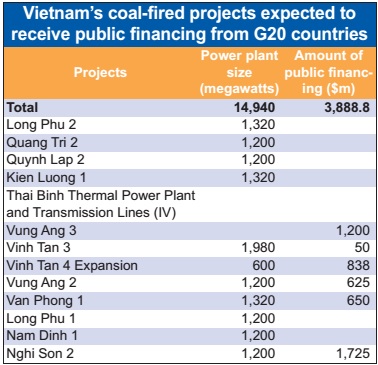G20 billions feed coal-fired future
 |
| G20 lending institution loans should help with coal goals |
The US-based Natural Resources Defense Council (NRDC), an international non-profit environmental organisation with over three million members, two weeks ago released a report stating that Vietnam will be the second-biggest borrower from G20 nations for its coal-fired power development. G20’s five largest coal financiers include China, Japan, Germany, Russia, and South Korea.
With Bangladesh up for $4.5 billion in G20 loans, Vietnam’s predicted tally comes to $3.9 billion for its 12 gigawatts (see box for details), followed by Indonesia ($3.8 billion), Brazil ($2.6 billion), and Pakistan ($2.4 billion).
Of the total $3.9 billion in loans for Vietnam, Japan will potentially provide almost $2.3 billion, with the rest of the prospective loans coming from South Korea.
 |
For example, PetroVietnam’s under-construction Long Phu 1 coal power project is said to be up for financing from several export credit agencies, including Servizi Assicurativi del Commercio Estero and the Export-Import Bank of the United States. However, with many of PetroVietnam’s former executives going on trial for corruption charges related to the bidding for engineering, procurement, and construction contracts, domestic and international groups have filed a complaint with potential funders to halt the project, according to NRDC.
Nguy Thi Khanh, founder and executive director of the Green Innovation and Development Centre (GreenID), told VIR that under GreenID’s report on coal finance in Vietnam released last May, Vietnam has mobilised nearly $40 billion to build its coal-fired power plants, with another $46 billion needed to complete the country’s coal-fired power development through 2030.
According to NRDC, during the 2013-2016 period, Vietnam was also the biggest borrower of G20 financing portfolios, with a total capacity of 9 megawatts enjoying loans provided by China, Japan, and South Korea.
According to Khanh, total foreign investment into coal-fired power projects in Vietnam has amounted to about $20.5 billion, including $4.5 billion from individual foreign investors, and $16 billion from 23 international financial organisations of eight nations and a multilateral organisation.
Experts said that such loans for Vietnam are often provided via bilateral agreements, and via loans for private investors to implement these projects in Vietnam.
Tran Van Quang, a senior energy expert from one of the largest foreign fund management groups in Vietnam told VIR, “Japan Bank for International Cooperation has provided a loan for Marubeni Corporation to implement the Nghi Son 2 Thermal Power Plant under the build-operate-transfer (BOT) format – this loan is not provided for Vietnam’s government. Similarly, the Export-Import Bank of Korea has also provided a loan for KEPCO to implement the Nghi Son 2 plant.”
According to Quang, in the time to come, the question of whether Vietnam can have new loans for its coal-fired power projects will depend on the country itself.
“[The estimates are that Vietnam will] need another $46 billion for coal-fired power development, but I think that $46 billion or even $460 billion are also the same. It is because before any investment decision, investors or national governments must carefully consider all relevant factors,” he said.
“In the electricity industry, the important factors include regulatory frameworks, power-purchasing agreements (PPAs), materials, and technologies. Of which, the regulatory frameworks and PPAs are in the hands of the Vietnamese side. Thus whether Vietnam will be able to secure new loans completely depends on Vietnam.”
Meanwhile, senior climate change expert Koos Neefjes told VIR Vietnam’s government cannot increase public debts or expenditures, or provide many more loan guarantees while state-owned enterprises like Electricity of Vietnam (EVN) or PVN borrow more. “Therefore private funding is needed, and much of that must be foreign investment, although there are also domestic banks participating already in the coal power plant consortia of financiers, working with project developers, construction companies, and equipment manufacturers,” Neefjes said.
“The private foreign investors need to operate and get revenue during the time that they own the plant – and after a certain period they may transfer to EVN under the BOT format, and at that time the outstanding debt will get on the books of EVN.”
| RELATED CONTENTS: | |
| Experts decry Vietnam’s risky coal compulsions | |
What the stars mean:
★ Poor ★ ★ Promising ★★★ Good ★★★★ Very good ★★★★★ Exceptional
Latest News
More News
- Mitsubishi Estate launches Logicross Hai Phong - a milestone in logistics evolution (November 20, 2024 | 14:32)
- Semiconductor workforce partnerships deliver industry-relevant training (November 20, 2024 | 10:58)
- German Quickpack to invest $31.7 million in Long An province (November 20, 2024 | 09:31)
- Foreign-invested enterprises drive logistics investment in the southeast region (November 20, 2024 | 09:27)
- Chile visit underscores trade benefits (November 19, 2024 | 10:00)
- Trump’s second term impacts sci-tech activities and industry 4.0 technologies (November 18, 2024 | 10:00)
- Vietnam eyes nuclear revival to bolster energy security (November 14, 2024 | 16:46)
- Kyokuyo completes $13.5 million seafood factory in Vietnam (November 14, 2024 | 12:19)
- VinFast receives $3.5 billion funding from Vingroup and Pham Nhat Vuong (November 14, 2024 | 06:38)
- Localities sprint to reach FDI targets (November 13, 2024 | 10:00)















 Mobile Version
Mobile Version